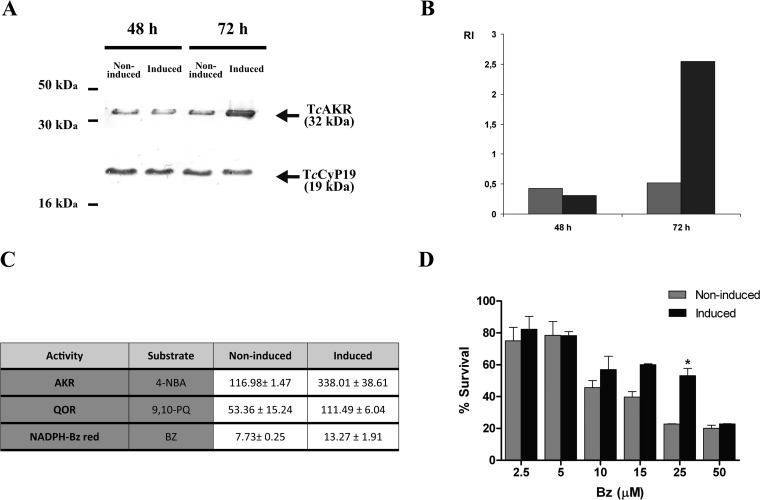FIG 1.
Overexpression of TcAKR and Bz susceptibility in transfected T. cruzi epimastigotes. (A and B) Time course of TcAKR expression in transfected T. cruzi. Noninduced and tetracycline-induced transfected epimastigotes were collected at different times and fractionated by 12% SDS-PAGE, and Western blots were probed with a mouse anti-recTcAKR serum. Equivalence in protein loading was controlled by immunodetection of TcCyp19. A representative Western blot (A) and semiquantitative analysis of TcAKR levels (B) are shown. Relative intensity (RI) was calculated as follows: intensity of the signal obtained with anti-recTcAKR/intensity of the signal obtained with anti-TcCyp19. (C) AKR, QOR, and NADPH-dependent Bz reductase (red) activities of TcAKR-transfected epimastigotes. Enzymatic activities were measured in the soluble fraction of transfected epimastigotes, either noninduced or tetracycline induced for 72 h. AKR and QOR activities were evaluated using 4-NBA and 9,10-PQ as substrates, respectively. NADPH was used as a cofactor in all the reactions. Results are expressed as nanomoles of NADPH/minute/milligram of protein. (D) Effect of Bz on the survival of TcAKR-overexpressing T. cruzi. Noninduced and tetracycline-induced pTcIndex-TcAKR-transfected parasites were cultured for 72 h in the presence or absence of different Bz concentrations. A survival rate of 100% corresponds to the mean number of duplicate samples of untreated epimastigotes. *, P < 0.05, for results in noninduced versus tetracycline-induced epimastigotes.

